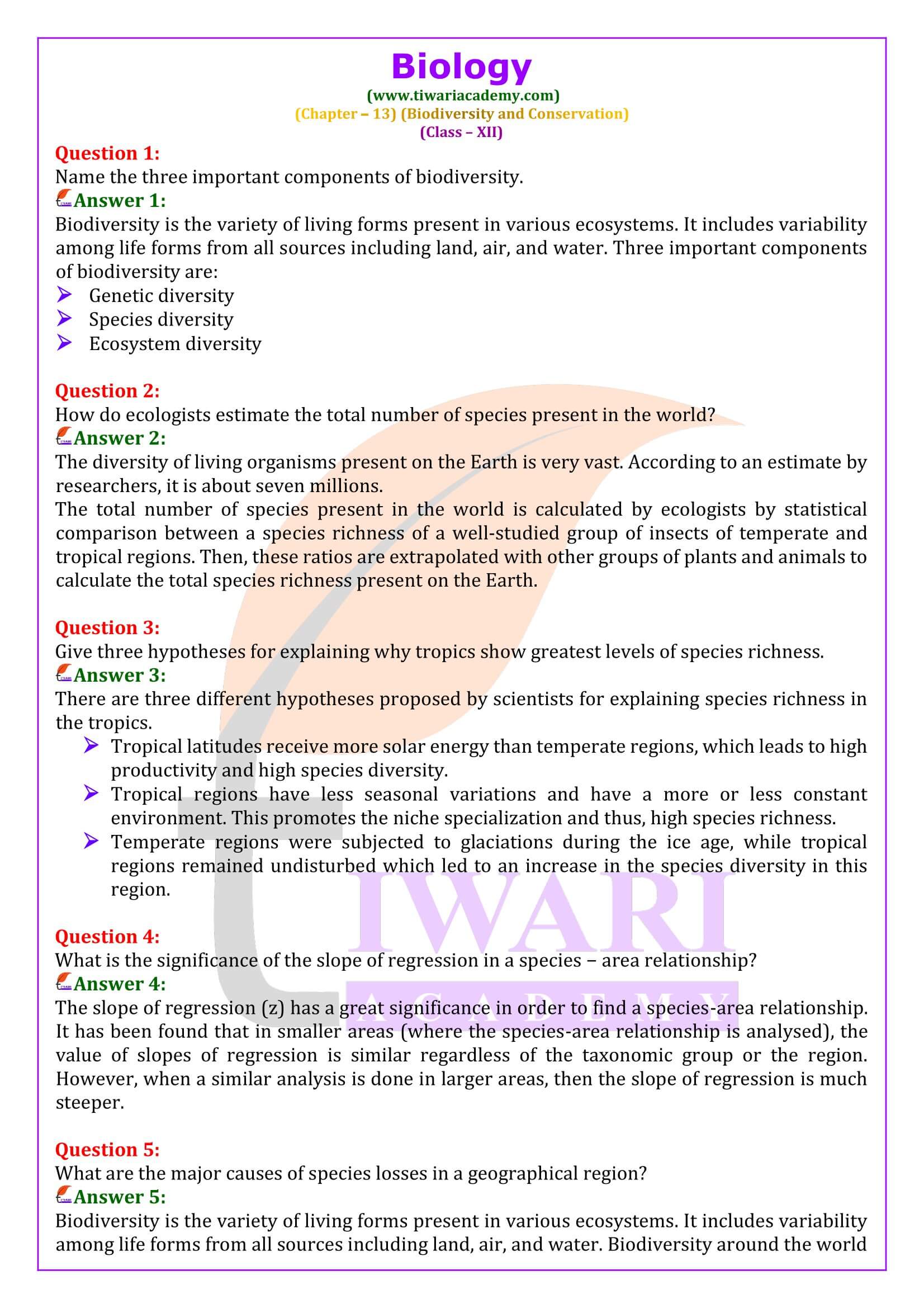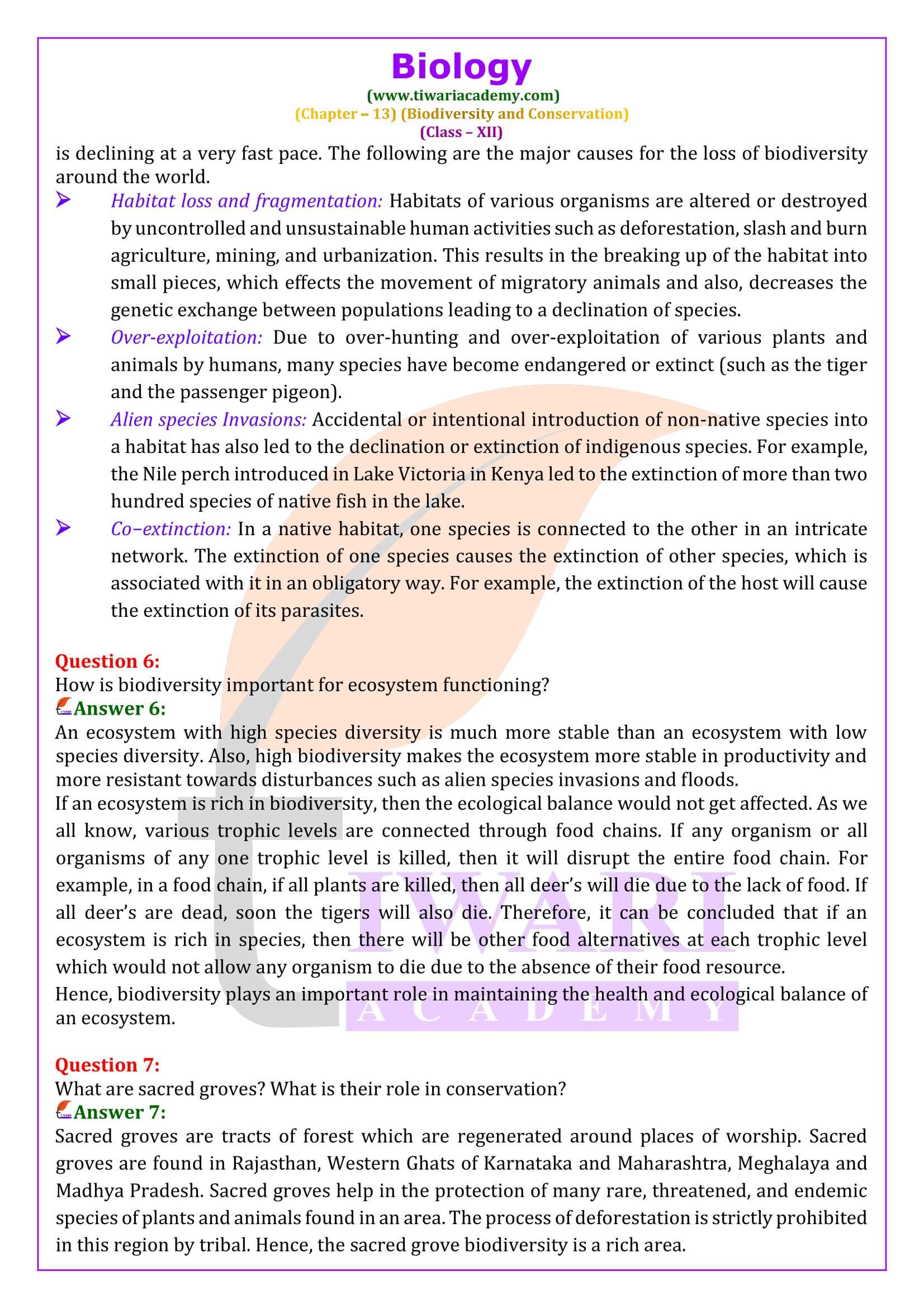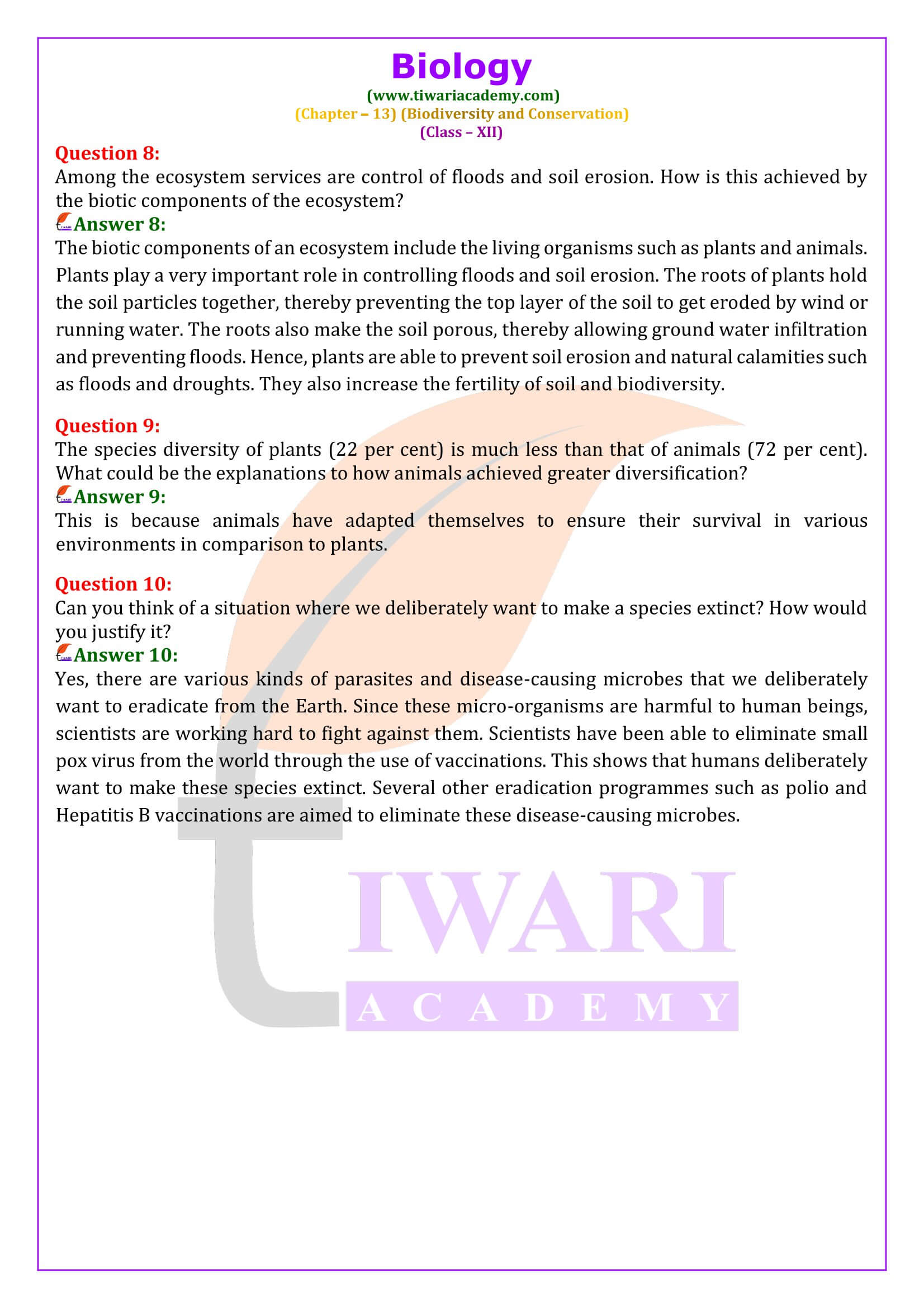NCERT Solutions for Class 12 Biology Chapter 13 Biodiversity and Conservation in Hindi and English Medium FREE in PDF format for all boards using NCERT Books and following CBSE Syllabus 2025-26. Download NCERT Books based on latest CBSE Curriculum in PDF format. Discuss Your Questions with others through Discussion Forum.
NCERT Solutions for Class 12 Biology Chapter 13
Class 12 Biology Chapter 13 Biodiversity and Conservation Solutions
| Class: 12 | Science |
| Subject: | Biology |
| Chapter 13: | Biodiversity and Conservation |
| Content: | NCERT Solutions and Extra Questions |
| Academic Session: | 2025-26 |
| Medium: | Hindi and English Medium |
Class 12 Biology Chapter 13 Solutions in English
NCERT Solutions for Class 12 Biology Chapter 13 in PDF format to free download for new academic session 2025-26. All the solutions are based on latest NCERT Books and following the new CBSE Syllabus 2025-26. Join the discussion Forum to ask your questions and reply to the other users.
Reasons for greater biological diversity in tropics
1. Tropical latitudes have remained relatively undisturbed for millions of years and thus had a long evolutionary time for species diversification.
2. Tropical environments are less seasonal, relatively more constant and predictable which promote niche specialisation and lead to greater species diversity.
3. There is more solar energy available in the tropics, which contributes to higher productivity and indirectly leads to greater biological diversity.
Three inter-related levels of Biodiversity
1. Genetic diversity: Diversity in the number and types of genes, as well as chromosomes present in different species and the variations in the genes and their alleles in the same species. It helps in speciation.
2. Species diversity: Varieties in the number and richness of the species of a region.
3. Ecological diversity: Variety in the types of ecosystems.
The Importance of Species Diversity
1. Ecosystems with higher bio diversity are more productive than ecosystems with lower biodiversity. David Tilman showed in his experiments that increased diversity contributes to higher productivity.
2. Biodiversity is essential for the stability of an ecosystem. Communities with more species are more stable than those with less species.
3. Rich biodiversity is also essential to make an ecosystem more functional and survival of the human race on the earth.
Important Questions on 12th Biology Chapter 13
What is the significance of the slope of regression in a species − area relationship?
The slope of regression (z) has a great significance in order to find a species-area relationship. It has been found that in smaller areas (where the species-area relationship is analysed), the value of slopes of regression is similar regardless of the taxonomic group or the region. However, when a similar analysis is done in larger areas, then the slope of regression is much steeper.
Name the three important components of biodiversity.
Biodiversity is the variety of living forms present in various ecosystems. It includes variability among life forms from all sources including land, air, and water. Three important components of biodiversity are: Genetic diversity Species diversity Ecosystem diversity.
Give three hypotheses for explaining why tropics show greatest levels of species richness.
There are three different hypotheses proposed by scientists for explaining species richness in the tropics. Tropical latitudes receive more solar energy than temperate regions, which leads to high productivity and high species diversity. Tropical regions have less seasonal variations and have a more or less constant environment. This promotes the niche specialization and thus, high species richness. Temperate regions were subjected to glaciations during the ice age, while tropical regions remained undisturbed which led to an increase in the species diversity in this region.
How do ecologists estimate the total number of species present in the world?
The diversity of living organisms present on the Earth is very vast. According to an estimate by researchers, it is about seven millions. The total number of species present in the world is calculated by ecologists by statistical comparison between a species richness of a well-studied group of insects of temperate and tropical regions. Then, these ratios are extrapolated with other groups of plants and animals to calculate the total species richness present on the Earth.
How is biodiversity important for ecosystem functioning?
An ecosystem with high species diversity is much more stable than an ecosystem with low species diversity. Also, high biodiversity makes the ecosystem more stable in productivity and more resistant towards disturbances such as alien species invasions and floods. If an ecosystem is rich in biodiversity, then the ecological balance would not get affected. As we all know, various trophic levels are connected through food chains. If any organism or all organisms of any one trophic level is killed, then it will disrupt the entire food chain. For example, in a food chain, if all plants are killed, then all deer’s will die due to the lack of food. If all deer’s are dead, soon the tigers will also die. Therefore, it can be concluded that if an ecosystem is rich in species, then there will be other food alternatives at each trophic level which would not allow any organism to die due to the absence of their food resource. Hence, biodiversity plays an important role in maintaining the health and ecological balance of an ecosystem.
Among the ecosystem services are control of floods and soil erosion. How is this achieved by the biotic components of the ecosystem?
The biotic components of an ecosystem include the living organisms such as plants and animals. Plants play a very important role in controlling floods and soil erosion. The roots of plants hold the soil particles together, thereby preventing the top layer of the soil to get eroded by wind or running water. The roots also make the soil porous, thereby allowing ground water infiltration and preventing floods. Hence, plants are able to prevent soil erosion and natural calamities such as floods and droughts. They also increase the fertility of soil and biodiversity.
What are sacred groves? What is their role in conservation?
Sacred groves are tracts of forest which are regenerated around places of worship. Sacred groves are found in Rajasthan, Western Ghats of Karnataka and Maharashtra, Meghalaya and Madhya Pradesh. Sacred groves help in the protection of many rare, threatened, and endemic species of plants and animals found in an area. The process of deforestation is strictly prohibited in this region by tribal. Hence, the sacred grove biodiversity is a rich area.
Can you think of a situation where we deliberately want to make a species extinct? How would you justify it?
Yes, there are various kinds of parasites and disease-causing microbes that we deliberately want to eradicate from the Earth. Since these micro-organisms are harmful to human beings, scientists are working hard to fight against them. Scientists have been able to eliminate small pox virus from the world through the use of vaccinations. This shows that humans deliberately want to make these species extinct. Several other eradication programmes such as polio and Hepatitis B vaccinations are aimed to eliminate these disease-causing microbes.
Causes of Biodiversity Losses
1. Habitat loss and fragmentation: This is most important cause of plants and animals extinction. For example: Tropical rain forest being destroyed faster. The Amazonian rain forest is called the lungs of the planet. It is being cut for cultivating soya beans.
2. Over exploitation: Many species extinctions are due to over exploitation by humans e.g. extinction of Steller’s sea cow, passenger pigeon in last 500 years.
3. Co-extinctions: When a species becomes extinct, the plant and animal species associated with it in an obligating way also become extinct.






